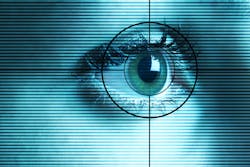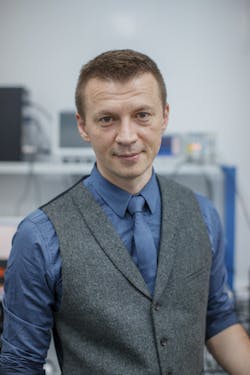How deep technology requirements drive optical opportunities
The birth of XPANCEO
This mission has driven the leaders to refer to their company as “deep tech,” engaged in both scientific and technical research but through the lens of best practices in technological and IT business methodology. As Axelrod explained, the goals of humanity for the next century cannot be met with the technology available today. Exploring the limitations of modern mobile devices and laptops, the company is focused on the concept of improving the interface, with the first conceptualization of this idea being to broadcast content directly to the retina.
When Axelrod approached Volkov with this vision, it provoked a level of intrigue: Could science and technology rise to the challenge? From that curiosity, XPANCEO emerged, and with it a company engaged in both fundamental research in the field of optoelectronics of new functional materials and the transfer of these scientific developments into the creation of a smart lens.
Path to the vision
Without their unique histories and career paths, this concept may have fallen flat. Coming together, the two leaders combined complementary skillsets to create a symbiotic relationship that supports a massive mission.
For instance, Axelrod brought with him an extended knowledge of breakthrough lens technologies, having followed the market closely and watched what has worked and hasn’t over the course of more than a decade. In addition, as a young serial entrepreneur, Axelrod had successfully built and facilitated the expansion of three companies into Western Europe, the U.S., and South Korea. This gave him a level of confident knowledge in navigating the startup realm—one that could lead to the ambitious project that became XPANCEO.
For Volkov’s part, his illustrious career in optics grew from a childhood interest in the natural sciences. At university, he uncovered a passion for optics and nanophotonics. He went on to receive his Ph.D. at Aalborg University in Denmark, where the doors to “great science” opened up. From there, he built a classic academic career: publishing high-quality science, developing scientific facilities, studying with the world’s most renowned experts in the field of nanooptics and photonics, lecturing and presenting globally, and overseeing high-caliber research institutions. In addition, Volkov began to dabble in entrepreneurial endeavors to take scientific results to commercial application, but found that particular expertise did not come as easily for him.
Yet when an experienced entrepreneur and a scientist with a passion for bridging research opportunities with commercial applications meet, opportunities emerge.
Breaking the optical barrier
Combining their expertise, Axelrod and Volkov dove into the exploration of smart lenses. Through their analysis of different variations, both for primary medical purposes and augmented reality (AR) applications, they realized that these solutions would face a fundamental barrier: classical optics. Applying traditional optics alone makes it impossible for the lens to be truly compact and comfortable for everyday wear.
Fortunately, as Volkov pointed out, the 21st century brought with it new versions of well-known materials, many of which are extremely promising: graphene, van der Waals materials and heterostructures, mxenes (MXenes), and perovskites. Each of these classes of materials are unique in their own way. Their structure and properties promise a great future in optoelectronics, integrated optics, biomedicine, solar energy, communications, and many other areas. It’s up to the industry to identify ways to tame these materials and put them to use for the service of humanity.
And so XPANCEO does. The company’s current work focuses on an approach that leverages the use of novel materials to create a lens.
The AR lens
For Axelrod and Volkov, their lens offers many opportunities. They see it as not only a medical device, but a new type of computer, with the most natural interface for interacting with the outside world. Ultimately, the lens will combine computing and connectivity capabilities, AR, and health hub functionality to enable regular monitoring of important health metrics.
In the near-term, they believe their new lens will enter the market and will solve niche problems associated with narrow professional and medical use cases. For example, their research indicates that the integration of miniature and sensitive biosensors into a contact lens will bring the idea of personalized medicine to a fundamentally new level. The lens will provide reliable monitoring of health status on a daily basis, and the use of smart functional materials will allow it to be trained to recognize individual biomarkers of dangerous ailments to support early detection of diseases. This will allow doctors to see health data from a smart lens in a patient’s medical record, gaining access to more complete information for diagnosis and treatment. They are also developing protypes for the lens that will enable a person to see in the dark or correct color blindness.
What’s next?
With their lens serving as a next-generation computer, the potential for new use cases abounds. Within the next five years, they believe there will be an emergence of optoelectronic devices that will completely change daily lives—and XPANCEO will play a significant role in this process.
For example, as Volkov points out, the use of smart contact lenses will finally make it possible in a global sense to move to medicine for everyone. In many ways, this is a change in the healthcare paradigm. By endowing the wearer of a smart lens with a personal bio-laboratory in the eye, the doctor/patient connection and interaction is strengthened. In fact, the recent pandemic has shown the value of such an approach via wearable electronics, such as smart watches, for health monitoring. As COVID-19 spread, smart watches that measured blood oxygen saturation became widely available, alerting people to a life-threatening symptom that is difficult to detect without assistance.
In a more far-off vision, the duo imagine that their lens will enable all forms of information to be transmitted directly to the retina, with possibilities in professional sports, teamwork, vocational training, and monitoring key health parameters.
Axelrod explains that through the continued study of the market and its constant changes, they can unlock the true potential for this technology. By tracking global patents in smart lenses and AR, they monitor the research directions of different players around the world, from medical companies to global IT giants. In addition, Volkov points out that their team includes scientists in the field of optics, nanophotonics, and small-sized materials. This sphere of technologists enables them to stay on the wave of the most advanced discoveries, to constantly learn new things.
Deep tech for the future
Based in Dubai, the company and its team are committed to their vision to transform the way people interact with the world. As Axelrod shared, they see themselves as one of the most promising deep-tech companies in the world, and within 10 years, they plan to become a prominent player in the creation and production of technology that meets next-generation demands.
Their advice to the industry? Don’t be afraid to think big. There is near limitless potential in what optic and photonic technologies can do, so by exploring the product possibilities—including the key problems they solve—the industry will collectively advance. And, as they say, being at least 10 times better than competitors doesn’t hurt, either. But above all, they encourage everyone to work with the assumption that the best is yet to come—because it is.
From where I stand, that’s sage counsel from two visionaries with a commitment to success.
About the Author
Jose Pozo
Chief Technology Officer, Optica
Jose Pozo joined Optica in March 2022, and has spent more than 25 years working in photonics. He earned a PhD in quantum physics from the University of Bristol (U.K.), and an M.Sc. and B.Eng. in telecom engineering from UPNA, Spain / VUB (Belgium). Prior to joining the European Photonics Industry Consortium (EPIC) in 2015 as CTO, Jose was a Senior Photonics Technology Consultant with PNO Consultants, with some of the main accounts such as CERN, Thales, and TE Connectivity. He has worked at TNO, The Netherlands Organization for Applied Scientific Research, and as a postdoctoral researcher at the Eindhoven University of Technology in the Netherlands, where he contributed to the early development of EFFECT Photonics.


